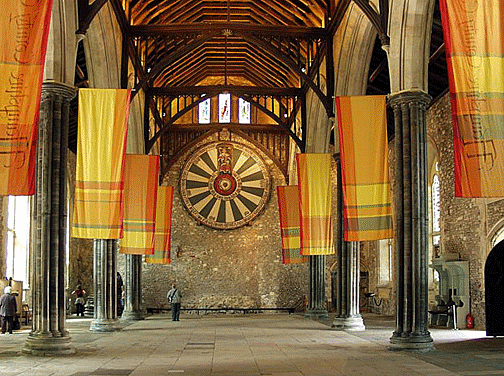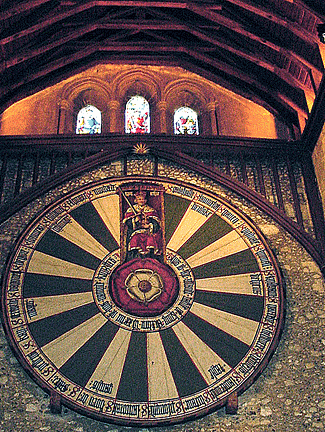|
 To
try to unravel the mystery surrounding him, I felt I had to visit some of
the places which lay claim to this "Once and Future King." The West Country,
Cornwall and Somerset in particular, abounds with more sites linked to
Arthur than any other part of England. To
try to unravel the mystery surrounding him, I felt I had to visit some of
the places which lay claim to this "Once and Future King." The West Country,
Cornwall and Somerset in particular, abounds with more sites linked to
Arthur than any other part of England.
I began my quest in Winchester, the old Roman city of
Venta Belgarum, site of the Great Hall, depository of the most famous of all
Arthurian relics, the Round Table.
Eighteen feet in diameter, made of solid oak and weighing approximately one
and a quarter tons, it hangs a table top without legs. It resembles an
enormous dartboard, painted in green and white segments, indicating the
places where the king and his knights once sat. In Malory's day, many
considered it to be the genuine article, and historians believed Winchester
Castle to be the site of Arthur's fortress, Camelot.
 Unfortunately,
the existing castle isn't nearly old enough to be of the Arthurian period.
Tests prove Edward III constructed the table, probably in 1344, when he
conceived the notion of an order of chivalry based on the Knights of the
Round Table as depicted in the popular romances. It was possibly used for
celebrating the then popular Arthurian festivals in which noblemen indulged. Unfortunately,
the existing castle isn't nearly old enough to be of the Arthurian period.
Tests prove Edward III constructed the table, probably in 1344, when he
conceived the notion of an order of chivalry based on the Knights of the
Round Table as depicted in the popular romances. It was possibly used for
celebrating the then popular Arthurian festivals in which noblemen indulged.
King Henry VIII ordered the table painted in 1522 to honor a visit by
Charles V. The image of Arthur is actually modeled on a very youthful Henry
VIII seated in full royal regalia. A Tudor rose marks its center.
Legend says that Merlin, the magician, conjured the table for Uther
Pendragon, Arthur's father. On his father's death, Merlin gave the table to
Arthur.
However, the idea of a table where all were equal, where no man sat in state
above his peers appealed to the romantic idealism which, especially in
Victorian times, surrounded the knightly legend. In fact, any leader of the
time would have had to impose a fierce discipline or risk being deposed.
INext:
Camelot
|
